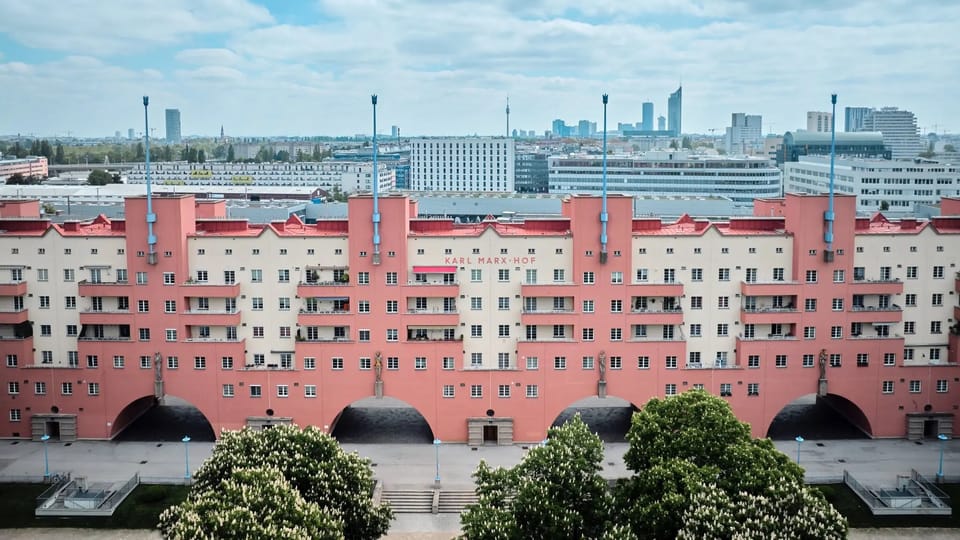Vienna's secret housing sauce

Ah, Vienna. At the end of June, The Economist named the small central European city – it has an urban population of around 2 million – the world's most liveable city for the third straight year. Australian cities – which usually do quite well in this survey – fell down the rankings "owing to an ongoing housing crisis that has led to an all-time low availability of rental properties in many of the cities".
Understandably, that warrants investigation: what is Vienna doing so well, and can we replicate it in Australia? According to the NYT, one reason Vienna does so well is because it's a "renters' utopia":
"Experts refer to Vienna's Gemeindebauten as 'social housing,' a phrase that captures how the city's public housing and other limited-profit housing are a widely shared social benefit: The Gemeindebauten welcome the middle class, not just the poor. In Vienna, a whopping 80 percent of residents qualify for public housing, and once you have a contract, it never expires, even if you get richer. Housing experts believe that this approach leads to greater economic diversity within public housing — and better outcomes for the people living in it.
…
Vienna's generous supply of social housing helps keep costs down for everyone: In 2021, Viennese living in private housing spent 26 percent of their post-tax income on rent and energy costs, on average, which is only slightly more than the figure for social-housing residents overall (22 percent). Meanwhile, 49 percent of American renters — 21.6 million people — are cost-burdened, paying landlords more than 30 percent of their pretax income, and the percentage can be even higher in expensive cities. In New York City, the median renter household spends a staggering 36 percent of its pretax income on rent."
That hasn't gone unnoticed in Australia. The Greens' housing spokesperson Max Chandler-Mather – whose party recently blocked Labor's build-to-rent bill – is a big fan of Vienna's housing model:

According to Chandler-Mather, we can't have nice Vienna-style accommodation because of our reliance on evil developers and market-rate housing:
"Did you know in Vienna nearly 60% of people live in beautiful rent capped housing? Labor wants to rely on private developers to fix this crisis."
And here he is again spruiking the Vienna model:
"The property industry and their allies will tell you the only way to tackle the housing crisis is to give property developers more power to do whatever they want. But that's what got us in this mess in the first place. Vienna proves the reality is the exact opposite."
The context missing from Chandler-Mather's takeaway is Australia. Countries have different cultures, norms, and institutions developed over hundreds of years, and they tend to be quite rigid, making it incredibly difficult to 'transplant' what works in one place somewhere else. I mean, Vienna's housing model hasn't even spread to the rest of Austria despite being around for a hundred years. And for all of its perks, it's far from perfect – for example, it favours the established middle class over "the really poor and needy", and is less "newcomer-friendly" than Australia's housing regime.
As a nation of immigrants, being newcomer-friendly and favourable to the poor are two features I think many Australians would value highly!
Not all sunshine and lollipops
A 2020 German report comparing Vienna with its own housing markets found a lot to praise, but also several pitfalls. I don't read German so I'm relying on an AI translation here, but the following issues were noted:
Intransparency: The housing market and policy in Vienna are described as extremely opaque, with essential data often missing or not published. Frequent policy changes make it challenging to maintain an overview, and as a result, the housing policy cannot be evidence-based.
High Costs: Despite the perception of affordability, the report argues that the costs associated with renting (e.g. maintenance; utilities) are borne by tenants, making the system more expensive.
Insecurity: The report mentions issues related to security for tenants, implying that the system may not be as secure as intended.
Conflict-Prone: The system is said to be prone to disputes.
Bureaucratic: The processes involved are criticised for being overly bureaucratic, which can be a barrier for residents seeking housing.
Unjust: From the perspective of socially disadvantaged tenants, the system is described as unjust, as it fails to adequately address their needs.
Regulatory Complexity: The dense regulation, while aimed at controlling the market, is sometimes handled creatively by those involved, which can lead to inconsistencies and further complications.
Data can be misleading! Published rents in Vienna are lower than in Germany, but Viennese tenants have to take on a lot of responsibilities (and costs) that in most other cities are picked up by the landlord. Pipes blocked? Pay for your own plumber. Dilapidated kitchen? Yeah, in Vienna you're forking out for the renovation, too.
But what about other factors commonly blamed on the lack of housing security, which Vienna's model appears to resolve, such as that it makes it difficult to start a family? Fertility rates in the developed world are currently at around 1.6 births per woman, i.e. well below the replacement rate of 2.1 (assuming no migration).
Surely, then, Vienna – with its wealth of affordable public housing – must have one of the highest fertility rates in the developed world? Not so:
"Vienna has a relatively low fertility rate compared with the rest of Europe, as each woman gives birth to on average just 1.41 children, based on the latest figures from 2017. However, in the last five years, fertility rates have risen, from 1.4 children per woman in 2012.
Compared to other regions in Austria the fertility rate in Vienna is relatively low (rank 8 among 9 NUTS2 regions)."
There are many causes of declining fertility, but work by the United Nations suggests that the decline is primarily due to "the increasing control that individuals – particularly women – are able to exercise over their reproductive lives". Other issues, including affordable housing, are likely less of a factor.
To be sure, housing is too expensive in Australia. According to research by the ANU, after adjusting for quality changes (e.g. bigger houses), real median house prices rose by around 50% between 2003 and 2022.
The same measure applied to rents shows that they rose just 20% since 1980! Still less than ideal, but that's a compound average annual growth rate of less than 0.5% and has more or less tracked real incomes:
"Rents have been a broadly constant proportion of household disposable income. However, many low-income households pay more than 30% of their disposable income because household incomes are distributed more widely than house rents. There has also been a major fall in the supply of public housing."
At least as far as the lowest income households are concerned, Australia and Austria are relatively similar (there's no data for Vienna specifically). In Australia, around 25% of those in the bottom quintile spend 40% or more of their disposable income on housing, versus around 23% in Austria. Both countries are below the OECD average of 28%:

As a whole, Australians spend "19% of their gross adjusted disposable income on keeping a roof over their heads", which is less than Austrians (again, there's no breakdown for Vienna), who spend 21%.
Housing is too expensive. But it's not as bad as the media make it out to be, renting hasn't got much more expensive relative to incomes, and the Vienna model isn't necessarily applicable, or desirable, for Australia.
Can we really blame developers?
Despite Chandler-Mather's many proclamations, it's not clear how property developers "got us in this mess". The evidence overwhelmingly points to local zoning laws and the people who, largely through sheer luck of being born before subsequent generations, work hard to prevent precisely the type of structures that Chandler-Mather wants from being built in Australia – medium and high density residential units. Even 'greedy developers' struggle to improve Australia's density when compared to cities like Vienna, which houses 4,326 people per km2, or about 10 times as many as Sydney (433 people per km2).
Not because they don't want to, but because we order them not to!
There's a reason even public housing is difficult to build in Australia, and it's also not because of greedy property developers: many Labor-led councils, in Labor-led states, are still NIMBY to the point of blocking public housing renewal projects for several years. Conservative seats are just as bad (or perhaps worse), but my point is that if you can't build public housing in councils aligned with your own political party, what chance is there for the rest of Australia, which is a much larger and more diverse country than the city of Vienna?
I'm all for exploring options to improve the housing situation in Australia, including through public or non-profit entities. But it's not as simple as pointing to a small, relatively homogeneous European city and claiming that it has some kind of secret sauce that would fix Australia's housing woes. Even if Australia’s politicians unanimously decided to go down that road, there are a lot of issues to work out first, including (but by no means limited to): where the public housing should be built; which authorities have the capacity and resources to develop, own and manage a large quantity of it; and how much will it all cost (plus who will pay)?
Presumably Chandler-Mather will eventually disclose how the Greens would go about transforming Australia into Vienna. If his solution is a public property developer, the unintended consequences will likely more than offset the benefits. If he wants to ban negative gearing and remove the capital gains discount to make housing more affordable, it will have a marginal impact on prices – maybe a few percent – but rents will increase.
Yes, the federal government would collect more revenue, but nothing close to the annual $16.5 billion estimated in a recent Greens-commissioned PBO analysis, which was a purely nominal, static calculation that did not properly account for the dynamic nature of behaviour, taxes, interest rates, or house prices.
That is, of course, assuming it's not all just a ploy to convince a few gullible inner city folk that just because a model has worked in Vienna for a hundred years that it's also the silver bullet for Australia's housing affordability crisis. Like independent senator David Pocock, Chandler-Mather tends to speak in half-truths; he tells a bunch of white lies that rile up the already-converted but will do little to convince those that have given these issues any serious thought.
Australia's housing market might not work perfectly and there's a lot that could be done to improve it, specifically on the supply side. But just because Vienna's secret sauce sounds good to some, we have to remember that there is no free lunch; success in one place doesn't mean success somewhere else. Every city and country has evolved with a different culture, different norms, and different legal systems (broadly speaking, institutions), which are difficult to transplant; you can't simply insert and stir.
We might wish we were more like Vienna but wishes tend not to make for good policy!


Member discussion